Bliss Charity Primary School

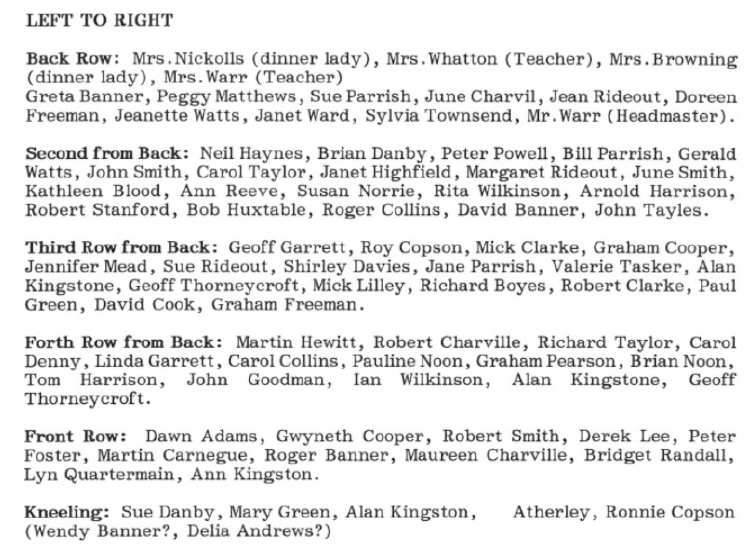
“Our Towns and Villages #45 Lower Heyford by Wayfarer”
Published in The Prattler – July & August 2020
Thanks to Shirley Collins
Bliss Charity Primary School


“Our Towns and Villages #45 Lower Heyford by Wayfarer”
Published in The Prattler – July & August 2020
Thanks to Shirley Collins
One day in 1930 three ladies were walking back to their homes in Nether Heyford. They had been attending the monthly meeting of the Women’s Institute in Bugbrooke, where they had been members for three years. They were Mrs J.O. dams, mother of Mr Hugh Adams, Mrs Punch, and Mrs George. As they walked along the quiet lane they discussed the formation of a W.I. in Nether Heyford, and Mrs Adams volunteered to see the County Secretary at W.I. House in Northampton. When the required ten ladies had been gathered together, the foundation papers were signed – with nervously shaking hands – in November 1930.
The Programme from 1938
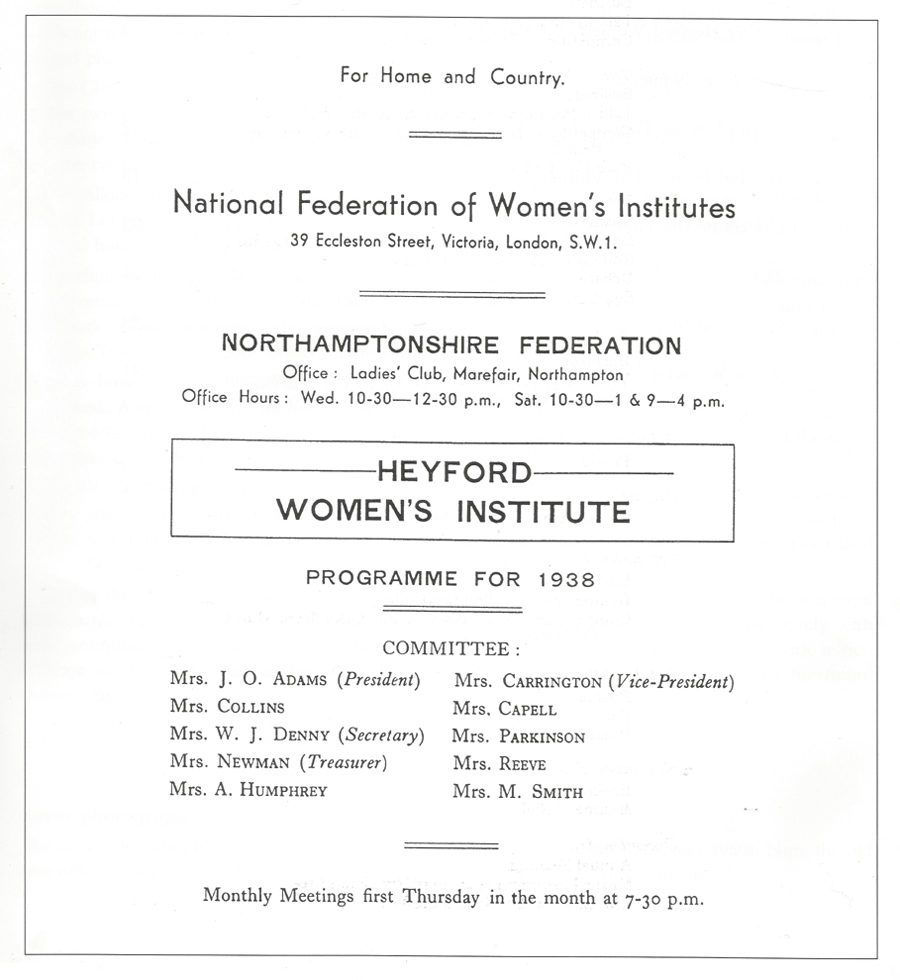
 The early years
The early years
Mrs Adams was the first President and Mrs George the Secretary. Their meetings were held in the school where Mrs Carrington, the Headmaster’s Wife, supplied the hot water to make the tea. Cups and saucers were loaned by the Baptist Chapel, carried over in a clothes basket and then washed up before their return. The activities were varied, speakers on subjects of interest to countrywomen, competitions of all kinds, and classes on old-time dancing and keep fit. Subscriptions were 2/6d which though seeming a small amount, was about on a par with those paid today.
A link was formed with a W.l. in Queensland, Australia, and members found much interest in exchanging news and views with an organisation on the other side of the world. During the War, parcels were gratefully received by members, in particular those containing soap, which was in very short supply. Another link nearer home, and in more recent days, was formed With Delapre Townswomens Guild. This continued for many years into the 1980s, with enjoyable get-togethers and exchange of ideas.
For many years meetings were held in the Baptist Chapel Schoolroom, but quite early on the W.I. had an ambition to have its own hall, so a Building Fund was established and money-raising events of all kinds began, including a garden party at the Manor house, then occupied by Mrs Shiel (Vice-Chairman at the time). The sum of £100 was raised, but the W.l. Hall was not to be and the money was eventually passed on to the committee set up to establish a Village Hall. This was eventually completed in 1960 on ground that had belonged to Mr Adams, With the help of village volunteers from all walks of life.

Wide ranging activities
The activities of the Institute are far—reaching. The subjects of our speakers and demonstrators are extremely varied. “Jam”? Yes, why not? And pickles, cakes, and grub of all kinds. Not to mention handicrafts, art, gardens, games and sport, local and family history, wild life and conservation, public speaking. “Jerusalem”? Well, no, not these days at our local meetings, though it is always sung with gusto at county and national events.
An annual produce show, open to all village residents, started in 1969, still continues in 1999, and creates much interest and fun.
Teams from our W.I. have done well in general knowledge quizzes run by the County Federation. In 1968 Mrs Judy Ward, Mrs Sheila Masters and daughter Hilary were the winners, and in 1994 we triumphed again, this time with Mrs Hyde, Mrs Essery and Mrs Joan Wright joining Mrs Masters.
For many years W.I. members have helped at the Blood Donors Clinic which is set up in the Village Hall twice a year. We serve the donors with the welcome tea and biscuits after they have given their life-saving blood.
Fund raising is a perennial occupation for all village organisations, and the W.I. is no exception. As well as making sure that we cover all our own expenses – speakers, hall fees, etc – these days we concentrate on raising funds for the Village Hall, now our regular and familiar meeting place. Money-making events include antiques evenings, occasional lunches (appropriately called ‘Nosh and Natter’) where senior citizens enjoy good food and good company, concerts (with, of course, nosh) and a stall (selling, of course, home—made nosh) at the annual Village Hall Fete, at which members have been known to dress up in weird and wonderful array — St Trinian’s and the Mad Hatters Tea Party are amongst the more memorable.
In the wider world our members take part in County Federation events. There is a tree planted in our name in Brixworth Country Park. Each year we discuss and vote on resolutions to be brought up at the National General Meetings, the results of which are passed to Governments, so that our W.I. plays an integral, if small, part in bringing subjects of importance to government attention, and action has been taken in many areas from these. Every few years we send a delegate to represent our W.I. and several others, and their reports are heard with great interest.
Canadian origins
All this started, not in England’s green and pleasant land, but in a small Canadian town called Stoney Creek, where a farmer’s wife, Mrs Hoodless, lost a child and realised that this was happening far too often to women of her generation owing to ignorance of simple health and hygiene rules. She made it her life’s work to help educate women so that they could have happy and healthy families. And on 19th February 1897 the first W.I. in the world was inaugurated at Stoney Creek.
The movement came to Britain in 1915 – the first W.I. being formed in Llanfairpwll in Anglesey, and the national Federation was established in 1917. One can scarcely believe that in those days it was difficult to find the 2/- (10p) subscription and to obtain the husband’s permission to attend meetings. However the enthusiasm of those early members surmounted all obstacles, and while the emphasis was on skills for country living, their horizons were immensely widened. I suppose it would be called ‘empowerment’ these days. Women who would have said they ‘couldn’t do anything,’ suddenly found that they could hold a meeting together, speak in public, demonstrate their skills and share their experiences. Many members have increased their skills and developed their talents at Denman College, the W.I.’s own Adult Education College in Oxfordshire. Opened in 1948 and named after Lady Denham, the first National Chairman, it offers courses to members on anything from painting to philosophy, from lace-making to local government, opening to women whole new worlds.
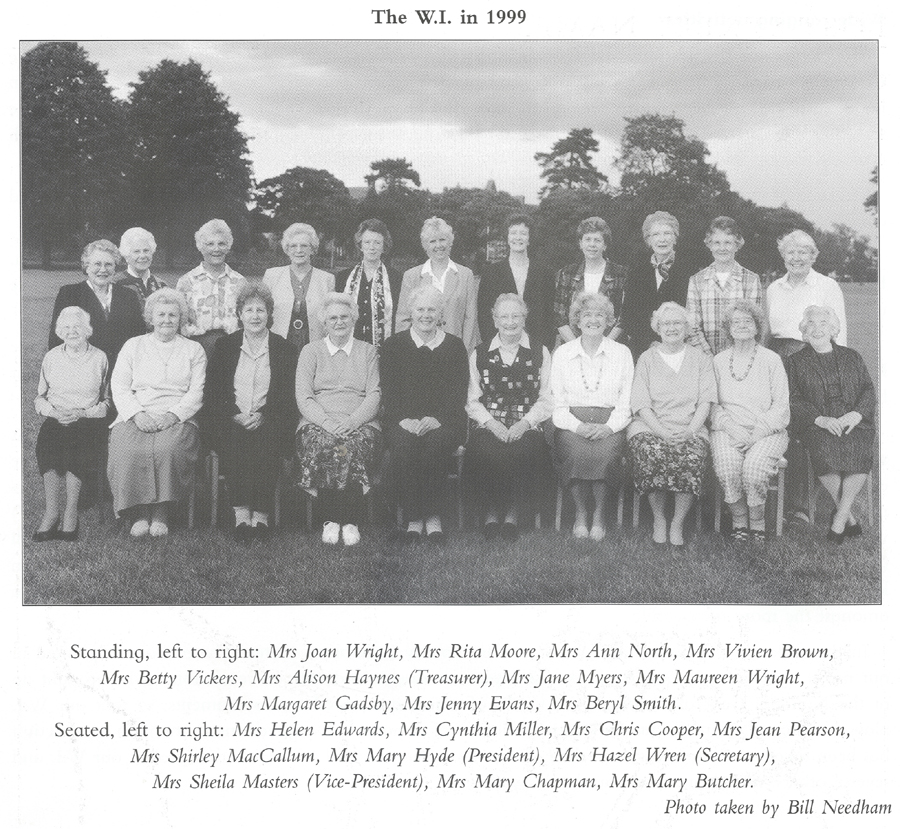
Seventy years and still going strong
Nether Heyford W.I. has passed its Silver, Golden and Diamond jubilees, and our ‘70th’, whatever that is called, comes up in the year 2000. It would take too much time and space to enumerate all the fine personalities who have graced our membership down the years. But we remember with pride some of those who have gone from us. Mrs Adams, the first and longest serving president – twenty-two years non stop. Mrs George, founder member and long time secretary and president. Mrs Nora Humphrey and Mrs Lou Garrett (later Robinson), both stalwart members and both serving as treasurer for many years. Mrs Ellen (Nen) Blaney, enthusiastic and generous-hearted member, Mrs Hilda Chapman, long serving secretary, instigator and for years the organiser of our produce show. Mrs Eve Gothard, County Committee member and enthusiast for our overseas connections. And Mrs Nellie Clements, willing, skillful, tireless committee worker, the kind of member who is the backbone of our movement.
Back in 1897, Canadian women chose for their motto, ‘For home and country’, and despite all the changes and modern improvements that have taken place down the century, it is difficult to think of a phrase that more closely reflects the purpose of the Women’s Institute movement.
Sheila Masters (with the help of Maureen Wright, and other members)
~~
Extract from “The Story of Heyford” – Local book series published in the late 1990’s
Volume 4 of 4 | Chapter 1 of 8 | Pages 2 to 6
The Census return of 1891
The details from Census Returns are not made available to the public until they are one hundred years old so the one most recently available to us is that of 1891. An analysis of this gives us a pretty good idea of what life in the village was like at the turn of the century.
The houses and people
The details below tell us about the number of houses, people and canal boats.
Lower Heyford
Upper Heyford
The houses listed as uninhabited were either vacant because the occupants were away on the night of the census, or more likely because they were uninhabitable.
A number of the families listed in the 1891 Census have continued to live in the area throughout the century: Names such as Adams, Charville, Clarke, Collins, Denny, Eales, Faulkner, Foster, Furniss, Garrett, Kingston, and Masters are still well known in the village today.
In those days street names were generally not used and there were certainly no house numbers. However several specific buildings are mentioned in the census.
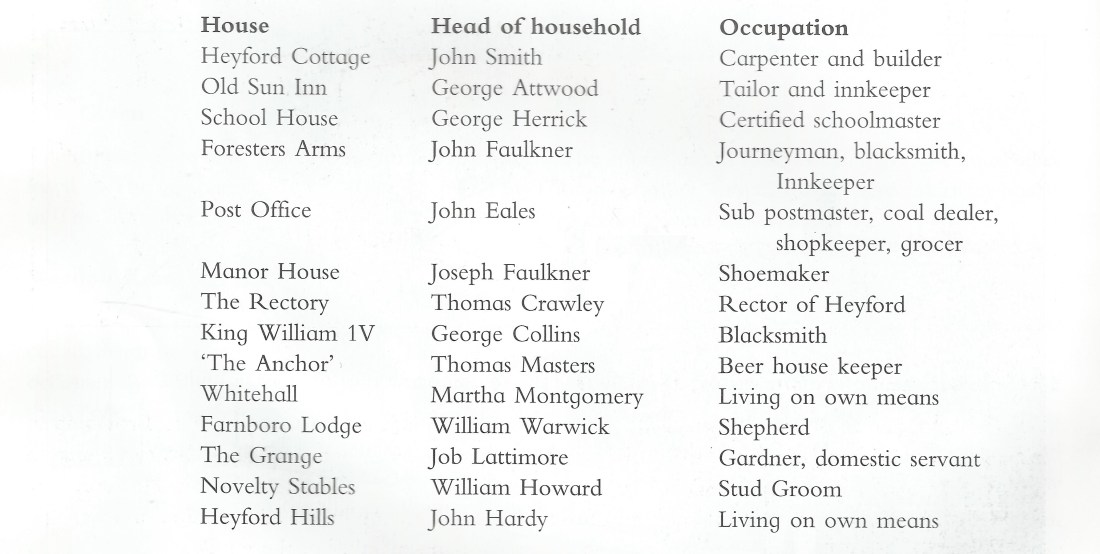
Working life
The occupations listed in the census also give some insight into working life in the village. Here is a breakdown into the main types of occupation.
Farming. The census lists 2 farmers, 2 flour millers, 1 milkman, 3 shepherds, 1 tractor engine driver and 26 agricultural labourers.
Building. 1 builder, 1 plasterer, 1 stonemason, 3 bricklayers and 7 carpenters.
Boot and shoe making. 5 shoemakers, 2 shoe rivetters, 1 boot and shoe finisher.
Other trades. 1 tailor, 2 lacemakers, 11 dressmakers, 2 blacksmiths, 1 harness maker, 1 wheelwright, 1 gunmaker, 3 boatbuilders, 1 organ builder.
Dealers. 1 butcher, 2 bakers, 3 coal merchants, 1 timber merchant, 1 corn merchant, 1 draper, 2 carriers, and 5 publicans, beer sellers and innkeepers.
Blast furnaces. These were the biggest single employers in the village with 1 blast furnace foreman, 2 blast furnace engine drivers, 2 stationary drivers, 1 engine fitter, 2 ironstone labourers, 1 weighboy, and 28 labourers.
Brickworks. 16 brickyard labourers.
Railway. 1 railway engine driver, 1 goods shed labourer, 1 engine fitter, 1 telegraph clerk, 3 signalmen and 4 platelayers.
Domestic and educational. 1 schoolmaster, 2 school mistresses, 1 clerk, 1 governess, 14 housemaids and domestic servants, 2 grooms, 1 nurse girl, 3 laundresses, 1 midwife.
Other. 28 general labourers.
The village as it appeared in 1900
The memories of Bob Browning (1892-1997)
Many of the details in the remainder of this chapter came from information given by Bob Browning to Stephen Ferneyhough on Tuesday 9th April 1996. Bob Browning was born in August 1892 and died in March 1997, aged 104. He was one of two brothers and four sisters all born in Nether Heyford. The story of this family appeared in Volume 2 of this series of booklets. All lived well into their nineties (94, 96, 98, 99, 101, 104) and Bob was the last and oldest surviving member of the family.
I visited him in his room at Bethany Homestead in Northampton. He was smartly dressed in a suit and tie. He greeted me with a handshake and made me feel very welcome by telling the nurse that I was a very good friend of his. He was very lively, interested in anything historical and was very glad to pass on anything he could for the interest of future generations. He lived in the village until he moved to Northampton in 1922, and most of the memories below are from that period.
Everyday life in Heyford
Life for most people was a matter of survival and self-sufficiency. The days were long, money was scarce and life was simple. Most families had an allotment and grew most of their own vegetable needs. After work in the light evenings, this was one of the main activities.
Most families kept hens. At harvest time the children went ‘gleaning’, that is picking up any remaining ears of corn to feed to the chickens. If a hen went broody, you’d put a dozen eggs under her in the spring time and so continue the supply of chickens and eggs.
Most people also kept a pig, usually in the backyard but sometimes on the allotment. The straw from the pigsty Was tipped onto the allotment, and the vegetable waste from the kitchen was fed to the pig. The boys went collecting acorns for the pigs in the autumn which they could sell for a tanner a bagful. The pigs were killed and butchered in the autumn to give a winter supply of meat. This was usually done by the butcher Ted Capel, and later by his son jack. The butcher went to the home or allotment to kill the pig. The meat was salted, and then laid in trays or hung in nets in the living room or hallway.
There were several farmers in the village producing milk. They delivered the milk, which was unpasteurised, each day in large cans. They had pint and half-pint measures which they filled and tipped into the jugs of the housewives who bought it. During the war there were shortages of anything that they couldn’t grow themselves. Sugar was rationed to half a pound a week. Butter was scarce and margarine became more common. However, they made a kind of butter by leaving the milk to stand overnight so that the cream came to the surface. By scooping it off and shaking it up they were able to make a sort of butter to use as a treat at the weekend.
There were two orchards in the village. john Barker had the one owned by the school behind Church Street. There was also Ben’s Orchard in Middle Street. This had a wall all around it, but it didn’t keep the boys out. They went scrumping for apples and pears in the autumn and stored them under the eaves the hayricks which were thatched for protection against the rain. They would always know the right time to retrieve them before the farmer came to dismantle the ricks. Nowadays there are no orchards, but the boys go garden hopping instead… presumably to get the same sense of excitement.
Lack of services
There was no sanitation, just an outside toilet. Some of these still exist in village as tool sheds or stores. but most have gone. The toilet would be emptied around once a week, usually onto the allotment. Sometime before the first world war the cart started coming. Two men employed by the council brought a two-wheeled cart pulled by horse to collect the toilet contents. It was then taken away for disposal. It had only two wheels to allow it to tip for emptying.
There was no gas or electricity. Gas came to the village just before the first world war via the Bugbrooke gasworks. Electricity didn’t come until after the second war. For light there were candles and oil lamps. For cooking there was a range with an open fire. On one side was a boiler for heating water and on the other side a small oven for baking cakes. You could divert the flames and heat to one or the other. On Sundays the wife would cook the vegetables, but the joint and yorkshire puddings were usually taken to one of the bakers for cooking while the family was at church or chapel. The main bakery for this was the one in Furnace Lane run by Wesley Faulkner. Most people had a bath once a week, often on Friday. Each house had a tin bath. The water for the bath was heated in the copper in the kitchen over an open fire. The fires were fuelled mostly by coal. There was a ready supply of coal to the village which came by canal. The Eales family who ran the post office kept a coal yard. Tom Dunkley at the Bricklayers Arms beside the canal also had a coalyard. He made deliveries by cart from which people would buy; enough to last the week.
The water supply consisted of four taps and many wells. There were four public taps in the village. One outside the jubilee Hall, one opposite the school outside Dennys house, one on the wall in Church Lane, and one near the Church rooms. A lot of the houses had wells, all supplied by the many springs in the area. The wells were dug two or three feet wide, five or six feet deep, and brick lined. The water was obtained by means of a bucket and rope. Later after the first war it became common to fit a handpump to the well.
The top of Church Street in 1913 This photograph, lent by Bob Smith, was taken in 1913 and shows a view from the top of Church Street. In the distance can be seen a small group of cottages, since demolished.
This photograph, lent by Bob Smith, was taken in 1913 and shows a view from the top of Church Street. In the distance can be seen a small group of cottages, since demolished.
The homes
Most of the houses were of stone (either limestone or sandstone) with thatched roofs and stone slabs for flooring. Some of the older ones like the tinsmith forge opposite the war memorial had mud walls. But many of the newer houses built late nineteenth and early twentieth centuries were of brick and slate with red quarry floor tiles. There was a brickworks in Furnace Lane where Wickes now is, but again the canal brought a ready supply of both brick and slate into the village. The owners of Flore Lane Wharf were dealers in brick and slate.
Inside the homes, most walls were plastered. This was made with a mixture of sand and lime. There were two good sandpits in Furnace Lane and there were a number of lime kilns along the canal which supplied slaked lime.
Church Street – the working heart of the village
In those days there were no street names or numbers. It was just ‘Barkers yard’ or ‘Tandy’s place’. Everybody knew who everybody was and where they lived.
The stone and thatch house behind the war memorial known as ‘the Springs’ was a laundry owned by a family called Smith. Sometime before the first world war the laundry was closed and the house was taken over by the Ward family.
In front of ‘the Springs’ was the Jubilee Hall. An article on this appeared in volume one of this series of booklets.
On the site of the jitty opposite the war memorial was a tinsmith forge. The path of the jitty then ran further to the left and came out beside the house known as ‘the Springs’. The forge was made of mud walls but became derelict and was demolished in 1920 when the New School house was built.
The small building to the right of the jitty which housed ‘Tops the Hairdressers’, and more recently ‘Heyford Antiques’ was built by William Browning, (Bob’s father) as a haberdashery and material business. Bob grandparents, Mr and Mrs Alfred Marsh (maternal side) lived next door.
To the right of this is a small three bedroomed cottage where the six Browning children were born and grew up. Behind these buildings was a saw pit and builders yard.
Next door is the house known as Tandy’s place. There used to be a right of way here through the yard to the jitty. Before Tandy was there it was occupied by a man named Gammage who ran a boot and shoe business. He married into the Faulkner family but later moved his business into Northampton. After he left it was taken over by Mr Tandy who made only heels and soles. He bought scraps from the leather factories and cut them up with special knives, building them up in layers to make heels and soles which were then sold on to shoe factories. After Mr Tandy left, it was occupied by a man named Williams who kept three or four cows and supplied milk to the village.
Further down Church Street, where the road turns sharply to the left, the red brick building on the inside of that corner was a bakehouse. It was owned by Thomas Faulkner who also ran the Methodist chapel for around 50 years until his death in 1940. He lived opposite in the stone and thatch building known as Ash Tree Cottage.
To the right of Ash Tree Cottage are some black doors. Here there used to be a blacksmith. The building belonged to the Faulkner family but the forge was used only once a week by Mr Green who came over from Flore. Later on it was Edward Wright who came (Bob Browning’s father in law). It was closed sometime before the second world war.
To the left of Ash Tree Cottage is Capel Cottage. so called because it was where a butchers business was run by the Capel family for three generations. Firstly by Ted before the first world war, then later by his son Jack. Most of the pigs in the village were slaughtered by the Capels.
Just around the corner was a small wheelwright shop run by Mr Foster. He learned his trade as an apprentice sponsored by the Arnold charity. The main local wheelwright was in Flore.
Further down Church Street, round the corner, almost opposite the Church is a stone, brick and thatch house that was a shop selling sweets, general groceries and beer. It was run by Mrs Oliver. Her husband worked on the roads (building and repairing).
Two views of Church Street
 This view of Church Street at the corner of Manor Walk shows Manor Cottage and Capell Cottage. The lady in the picture is Mrs David Browning.
This view of Church Street at the corner of Manor Walk shows Manor Cottage and Capell Cottage. The lady in the picture is Mrs David Browning.
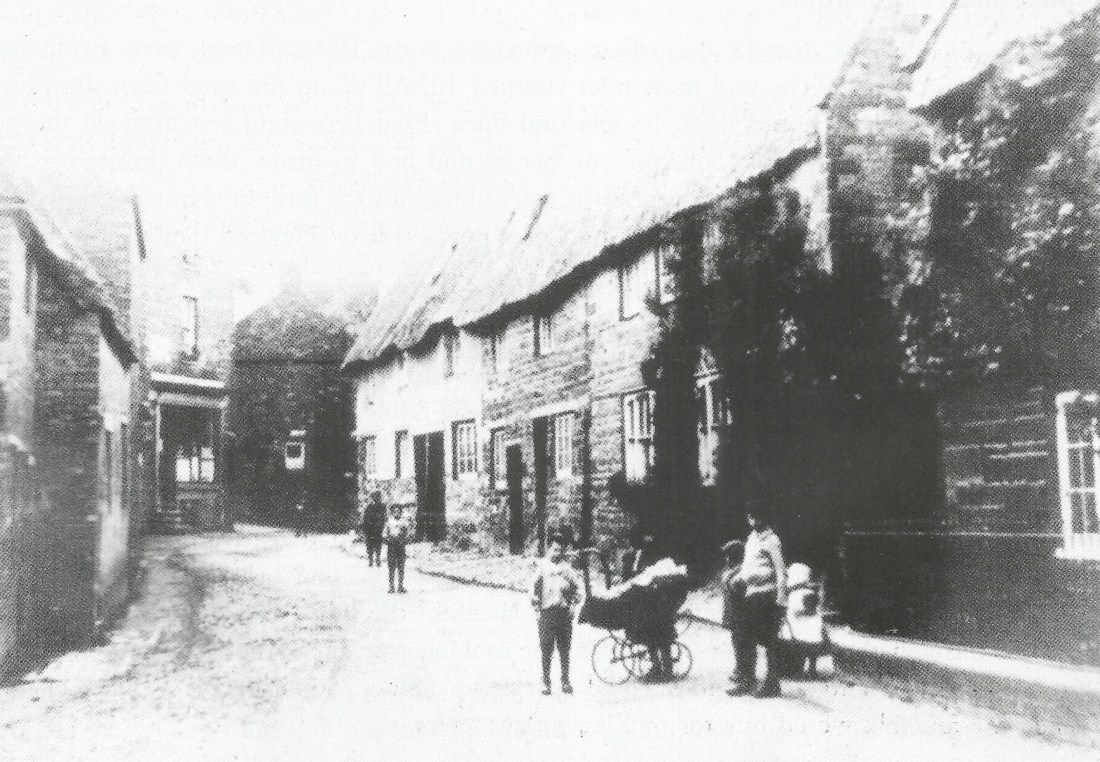 This picture above shows the row of cottages between the two bends in Church Street. The ones at the far end have since been demolished.
This picture above shows the row of cottages between the two bends in Church Street. The ones at the far end have since been demolished.
Stephen Ferneyhough
~~
Extract from “The Story of Heyford” – Local book series published in the late 1990’s
Volume 4 of 4 | Chapter 3 of 8 | Pages 12 to 17
Nether & Upper Heyford Home Guard (WW2)
The Home Guards met twice a week in the yard of the Foresters Arms, where they had their stores. The Commanding Officer was Charlie Highfield, chosen because of his army career.
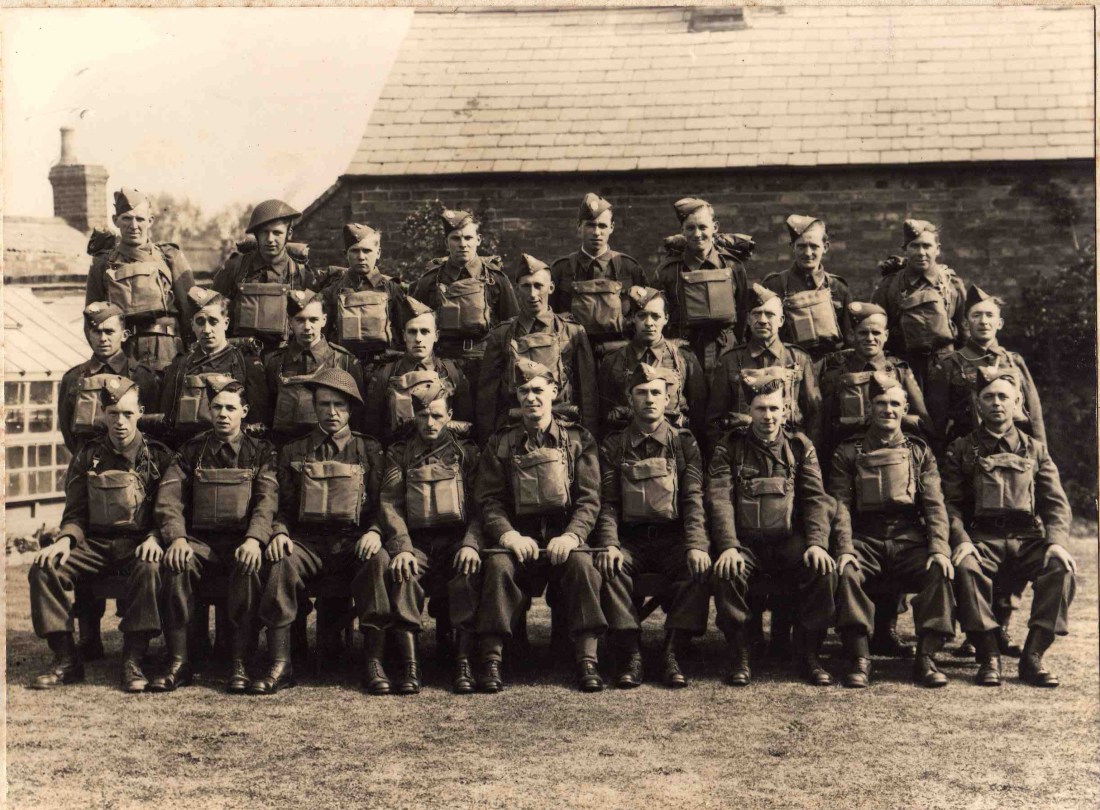
Back row (L>R):
Alf Adams, Stan Faulkner, Joe Matthews, Arthur (Batty?) Charvill, Jeff (Geoff?) George, Dick Fisher, Ron or Frank (?) Taylor, Fella Masters (the only name he was known by!)
Middle row (L>R):
Reg Collins, Tom Eales, Charlie Masters, Jack Butcher, Frank Reeve, Dave Ward, Herbert (Horace?) Blood, Amos Lee, Les (Bob?)Foster
Front row (L>R):
Bill Spokes, Anselm Banner, Sid Blencowe (Joe?), Harry Haynes, Charlie Highfield (Captain), Ted Wright, Joe Garratt, Joe (Joey?) Charvill, Arthur Mead
Thank you to the following villagers for the names: Joe Garratt / Michelle McMillan / Tom Harrison / Anna Forrester / Garry Collins / Zoe Highfield / Richard Eales / Keith Clarke / Trev Clarke / John Butcher / Charlene Zambo / Shirley Collins
Follow more Nether Heyford history, stories and photos on the Facebook group – Nether Heyford Past “Thanks for The Memories”
Please contact The Prattler if you can confirm any of the name spellings or nicknames. Also if you have any information on the Home Guard activities or any memories to share then send them in and we can update this page.
Jez Wilson
The Jubilee Hall used to stand just behind the memorial green, on the opposite side of the road to where the Butchers and Patisserie are today. It was a stone barn with a thatched roof and was used as a meeting place for clubs and events much as the village hall is used today .
It was an ancient building, possibly built in the late 1600’s at the same time as ‘The Springs’, the thatched stone house which still stands today just behind the site of the Jubilee Hall. In the late 1800’s and early 1900’s the house and barn were occupied by a family called Smith who ran a laundry there. Bob Browning who was born in 1892 recalled the laundry but we don’t know for sure whether it was run from the house or the barn.
The name Jubilee Hall is believed to have originated from Queen Victoria’s Jubilee, probably her Diamond Jubilee of 1897. It may be that this was when the barn began to be used as a meeting place rather than as a laundry.
In 1914 the house and barn which had been owned by the Church were bought by the Ward family The Jubilee Hall continued to be used as a meeting place until around the time of the second world war, and we have several local memories of it from the 1920’s and 1930’s.
The Jubilee Hall
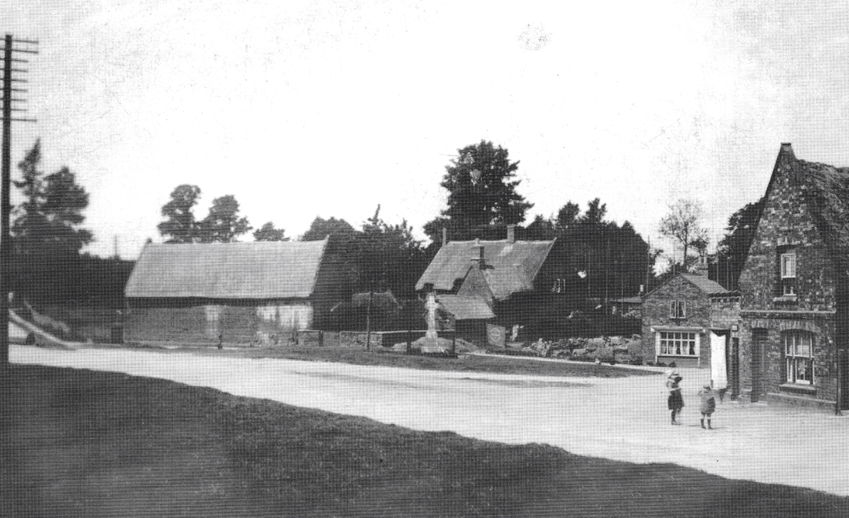
Photo lent by Janet Randall
This photograph, lent by Janet Randall, was taken in 1920. n the far right is the old Post Office. To the left of this can be seen the scaffolding from the building of the New School House. In the centre of the picture is the thatched house known as ‘The Springs’, and in front of this is the war memorial. Note the size of the oak tree beside it. The building on the left is the Jubilee Hall.
Memories of the Jubilee Hall
In March 1981 there was an article published in the Prattler, written by Marjorie Hamborg, based on information from Mr and Mrs Amos Lee, which gives a good insight into its use. This article is reprinted here in italics but we have also added some additional information based on the recollections of a number of other local people.
From The Prattler March 1981
“Our readers may have noticed that to the left of the thatched cottage facing the Memorial Green there is an old wall built of Northamptonshire stone. As this is now being reshaped to camouflage the building of a garage, I thought it would be of interest to know a bit about the history of this part of Heyford. So I visited my friends Mr and Mrs Amos Lee in Furnace Lane as they can give us new villagers some of the history of the Jubilee Hall that used to stand on this site.
At one time this was the only place where the young folk could gather, and here they came to play darts, skittles, rings, bagatelle, and a bit of boxing.”
It was also used for private parties. Dorothy Kingston had her Wedding reception there and Tommy Rolfe of the Foresters supplied them with a ham for £1.
The Pussyfoot Club
“The hall was mainly used by the men of the village, was teetotal, and was given the name ‘Pussyfoot Club’. The ladies of the village were invited when a dance was held there. Mrs Dorothy Kingston remembers them well, the fiddle being played by Lily Porch and Bern Kingston, and the piano by Lily’s sister Phillis. I also understand that Mrs Cameron from the school also used to take part. There was a small stove around which wet clothes could be dried in bad weather.”
Bob Browning who was born in 1892 recalled that ‘it was open six evenings a week between 6 pm and 10 pm. You could buy drinks there and play skittles. Sometimes there was also boxing, done in those days with bare fists.’
Bill Nickolls also remembers the Pussyfoot Club. The youngsters came from 5 pm to 8 pm. They paid a halfpenny per night to play darts, billiards, skittles and cards. Later the older ones came. They took it in turns to run the bar. Bill remembers on one occasion how somebody put a firework in the keyhole. The door jammed and they had to escape through the toilet window by climbing on the bucket.
Bill Kingston remembers the dances on Saturday nights. His father Bernard, and Lily Porch (later Mrs Green) played the violin. They danced waltzes, the military two-step and the lancers (a formation dance).
“However partly due to agitation by mothers whose sons became too fond of the card games carried on there, and partly to difficulty of getting committee members to organise events, the hall fell into disuse.”
The Laundry
“Before Mr and Mrs Ward came to live in the cottage Mrs Lee’s stepmother had a laundry there and Mrs Ada Smith can remember as a child seeing Mr Lee trundling his basket of clean laundry up Furnace Lane.”.
Cobblers Shop
Another person remembered with the Jubilee Hall during the 1930’s was Sid Eales. There was a small wooden hut next to the Jubilee Hall in which he ran a cobblers shop. He had been injured during the first world war and walked with a limp. He not only mended shoes, but would also take bets on your behalf if you wanted him to.
Fire wood and the black market
Jack Haddon had a timber yard a little way up Weedon Road Where the Randalls now live.
“Mr Lee tells me that during the second world war years the hall was used for chopping firewood and he remembers what a grand employer Jack Haddon was, working alongside Mr Lee, Mr Andrews, three or four women from the village and others, and there was a good trade with the bundling machine working at full blast. The wood came from as far as Brockhall Park and was stored in the paddock at the side.”
Jack Haddon apparently also did some black market dealing there during the War. There’s a story which says that while a deal was being struck inside the hall there was some panic because the local bobby was seen approaching. “Don’t worry,” said Jack reassuringly, “he’s only coming to pick up his joint!”
The Final days
When at last the hall was no longer used it fell into disrepair. Around 1954 the building had become unsafe, and when David Ward removed one of the beams it finally collapsed. Mr Ward had the wall built along the boundary line and many of the remaining slabs of stone disappeared in various directions.
Weedon Road/Furnace Lane
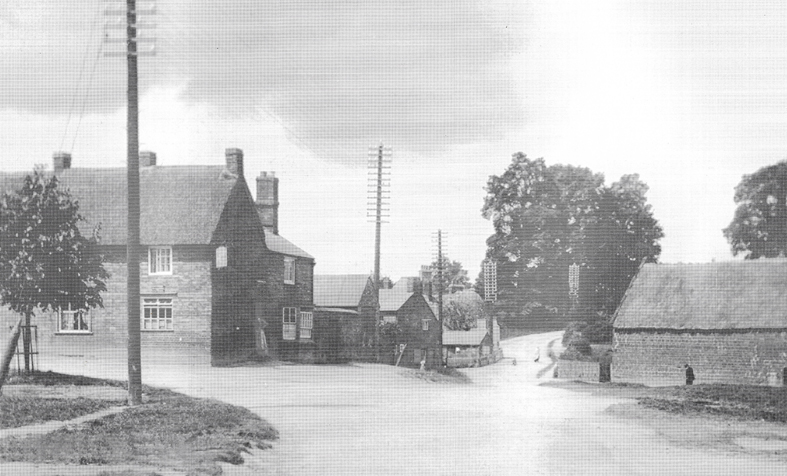
Photo lent by Janet Randall
This photograph shows the view along the Weedon Road. The Jubilee Hall is on the right hand side and Sid Eales Cobblers shop can be seen at the end of the building. On the left of the picture is the butchers shop and slaughterhouse. Note also the telegraph poles and the lack of proper kerbs and pavements.
Margorie Hamborg and Stephen Ferneyhough
~~
Extract from “The Story of Heyford” – Local book series published in the late 1990’s
Volume 1 of 4 | Chapter 7 of 13 | Pages 13,14 & 15